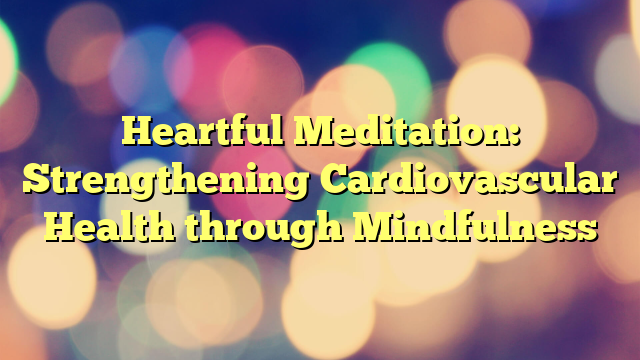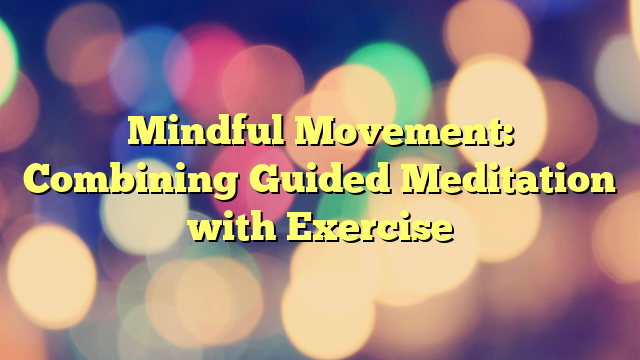Heartful Meditation: Strengthening Cardiovascular Health through Mindfulness

Heartful meditation, also known as mindfulness meditation, has gained significant attention in recent years for its potential benefits in promoting cardiovascular health. This ancient practice involves focusing one’s attention on the present moment and cultivating a non-judgmental awareness of thoughts, emotions, and bodily sensations. By integrating mindfulness into our daily lives, we can potentially improve our cardiovascular well-being and enhance overall health.
Understanding Cardiovascular Health
Before delving into the relationship between heartful meditation and cardiovascular health, it is important to understand what cardiovascular health encompasses. The cardiovascular system includes the heart, blood vessels, and blood, working together to deliver oxygen and nutrients throughout the body. Maintaining cardiovascular health is crucial for proper functioning of all organs and systems.
Cardiovascular diseases, such as coronary artery disease, stroke, and heart failure, are leading causes of death worldwide. Risk factors for these conditions include high blood pressure, high cholesterol levels, obesity, diabetes, smoking, and a sedentary lifestyle. While medical interventions play a vital role in managing cardiovascular diseases, adopting a holistic approach that includes lifestyle modifications can significantly improve outcomes.
Here are some ways to improve cardiovascular health:
- Exercise regularly: Engaging in physical activities such as walking, jogging, or cycling can strengthen the heart and improve blood circulation.
- Maintain a healthy diet: Consuming a balanced diet that is low in saturated fats, cholesterol, and sodium can help prevent the development of cardiovascular diseases.
- Manage stress: Incorporating stress-reducing techniques like heartful meditation can reduce the risk of cardiovascular problems.
- Quit smoking: Smoking damages the blood vessels and increases the risk of cardiovascular diseases. Quitting smoking can significantly improve cardiovascular health.
- Control blood pressure and cholesterol levels: Regular monitoring and management of blood pressure and cholesterol levels can reduce the risk of heart disease and stroke.
The Mind-Body Connection
The mind and body are interconnected, and research has increasingly demonstrated the impact of psychological factors on physical health. Stress, anxiety, and negative emotions can contribute to the development and progression of cardiovascular diseases. On the other hand, cultivating positive emotions, reducing stress, and improving emotional well-being can have a positive influence on cardiovascular health.
Heartful meditation serves as a powerful tool to cultivate mindfulness and improve emotional well-being. By practicing this form of meditation, individuals can develop a greater sense of self-awareness, emotional regulation, and resilience. These qualities can help in managing stress, reducing anxiety, and promoting overall mental well-being.
Here are some ways heartful meditation can improve emotional well-being:
- Stress reduction: Heartful meditation activates the body’s relaxation response, leading to a decrease in blood pressure and heart rate. This relaxation response helps individuals manage stress more effectively.
- Emotional regulation: By practicing mindfulness, individuals can develop the ability to observe their emotions without judgment. This allows for better emotional regulation and a reduction in negative emotions.
- Resilience: Heartful meditation cultivates resilience by helping individuals develop a non-reactive and non-judgmental mindset. This can lead to better coping mechanisms and increased emotional well-being.
The Impact of Heartful Meditation on Cardiovascular Health
Numerous studies have explored the impact of heartful meditation on cardiovascular health. Research suggests that regular practice of mindfulness meditation can lead to several physiological and psychological benefits that contribute to better cardiovascular well-being. Let’s explore some of these benefits:
1. Stress Reduction
Stress is a major risk factor for cardiovascular diseases. Chronic stress can lead to increased blood pressure, elevated heart rate, and inflammation, all of which can contribute to the development of cardiovascular problems. Heartful meditation has been shown to reduce stress levels by activating the body’s relaxation response, leading to a decrease in blood pressure and heart rate. By incorporating mindfulness into daily life, individuals can effectively manage stress and promote cardiovascular health.
Here are some additional ways heartful meditation reduces stress:
- Cortisol regulation: Heartful meditation has been found to regulate cortisol, the stress hormone. By reducing cortisol levels, mindfulness meditation helps individuals experience a greater sense of calm and relaxation.
- Improved mood: Regular practice of heartful meditation has been associated with improved mood and a decrease in symptoms of anxiety and depression. This positive emotional state contributes to a reduction in stress levels.
- Enhanced self-awareness: Heartful meditation increases self-awareness, allowing individuals to identify and address sources of stress more effectively. This awareness helps in adopting healthier coping mechanisms and reducing stress.
2. Blood Pressure Management
High blood pressure, or hypertension, is a significant risk factor for heart disease and stroke. Multiple studies have found that heartful meditation can help lower blood pressure. By inducing a state of relaxation and reducing stress, mindfulness can lead to a decrease in blood pressure and contribute to better cardiovascular health.
Here are some additional ways heartful meditation helps manage blood pressure:
- Vasodilation: Heartful meditation promotes vasodilation, the widening of blood vessels, which leads to improved blood flow and decreased resistance in the arteries. This helps lower blood pressure.
- Reduced sympathetic activity: By reducing sympathetic activity in the autonomic nervous system, heartful meditation helps relax blood vessels and reduce blood pressure.
- Improved endothelial function: Mindfulness meditation has been shown to improve endothelial function, which plays a key role in maintaining healthy blood pressure levels. By enhancing endothelial function, heartful meditation contributes to better blood pressure management.
3. Improved Emotional Well-being
Emotional well-being plays a crucial role in cardiovascular health. Negative emotions, such as anxiety and depression, can increase the risk of cardiovascular diseases. Heartful meditation promotes positive emotions, such as gratitude, compassion, and joy, while reducing negative emotions. By cultivating emotional well-being through mindfulness, individuals can potentially lower their risk of developing cardiovascular problems.
Here are some additional ways heartful meditation improves emotional well-being:
- Gratitude and compassion: Heartful meditation encourages individuals to cultivate gratitude and compassion towards themselves and others. These positive emotions have been linked to improved emotional well-being and a reduced risk of cardiovascular diseases.
- Emotional resilience: Regular practice of heartful meditation enhances emotional resilience, which allows individuals to bounce back from challenging situations. This resilience contributes to improved emotional well-being and overall cardiovascular health.
- Enhanced self-compassion: Heartful meditation helps individuals develop self-compassion, which involves treating oneself with kindness and understanding. Self-compassion has been associated with lower levels of stress and improved emotional well-being.
4. Enhanced Autonomic Function
The autonomic nervous system regulates various bodily functions, including heart rate, blood pressure, and digestion. Heartful meditation has been found to positively influence autonomic function by increasing parasympathetic activity (the rest and digest response) and decreasing sympathetic activity (the fight-or-flight response). This balance in the autonomic nervous system can help regulate heart rate and blood pressure, contributing to better cardiovascular health.
Here are some additional ways heartful meditation enhances autonomic function:
- Parasympathetic activation: Mindfulness meditation activates the parasympathetic nervous system, which promotes relaxation and counteracts the effects of stress. This activation leads to a decrease in heart rate and blood pressure, contributing to better cardiovascular health.
- Sympathetic inhibition: Heartful meditation reduces sympathetic activity, which helps individuals experience a sense of calm and relaxation. By inhibiting the fight-or-flight response, mindfulness meditation supports overall autonomic balance and cardiovascular well-being.
- Improved heart rate variability: Regular practice of heartful meditation has been associated with improved heart rate variability, which is a marker of autonomic function. Increased heart rate variability indicates a more flexible and adaptive autonomic nervous system, contributing to better cardiovascular health.
5. Improved Sleep Quality
Quality sleep is essential for cardiovascular health. Lack of sleep or poor sleep quality has been associated with an increased risk of developing cardiovascular diseases. Mindfulness meditation has shown promising results in improving sleep quality by reducing insomnia symptoms, enhancing sleep duration, and promoting relaxation. By incorporating heartful meditation into a daily bedtime routine, individuals can potentially improve their sleep and positively impact cardiovascular health.
Here are some additional ways heartful meditation improves sleep quality:
- Relaxation and stress reduction: Heartful meditation helps individuals relax their minds and bodies, promoting a state of calmness that is conducive to quality sleep. By reducing stress levels, mindfulness meditation contributes to better sleep quality.
- Mindfulness-based stress reduction: Mindfulness-based stress reduction (MBSR) programs, which often include heartful meditation, have been shown to improve sleep quality in individuals with insomnia. These programs teach individuals how to manage stress and cultivate a state of relaxation for better sleep.
- Enhanced sleep duration: Regular practice of heartful meditation has been associated with increased sleep duration. By promoting relaxation and reducing racing thoughts, mindfulness meditation helps individuals fall asleep faster and stay asleep longer.
Integrating Heartful Meditation into Daily Life
To experience the potential benefits of heartful meditation on cardiovascular health, it is essential to integrate this practice into daily life. Here are some tips to get started:
- Find a quiet and comfortable space where you can practice meditation without distractions.
- Set aside a specific time each day for meditation. Start with a few minutes and gradually increase the duration.
- Begin by focusing on your breath. Notice the sensation of each inhale and exhale, allowing your mind to settle in the present moment.
- As thoughts or distractions arise, gently acknowledge them without judgment and redirect your attention back to your breath.
- Explore guided meditation resources, such as apps or online videos, to support your practice and learn new techniques.
- Consider joining a meditation group or attending mindfulness workshops for additional guidance and support.
Remember, consistency is key. Regular practice of heartful meditation can lead to long-term benefits for cardiovascular health and overall well-being.
In conclusion, heartful meditation offers a holistic approach to promoting cardiovascular health through mindfulness. By reducing stress, managing blood pressure, improving emotional well-being, enhancing autonomic function, and promoting better sleep quality, this practice can potentially contribute to a healthier heart and a healthier life. Start your journey towards cardiovascular well-being today by incorporating heartful meditation into your daily routine.

